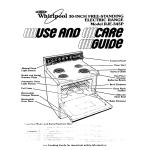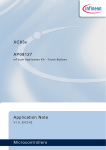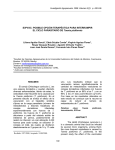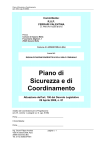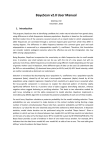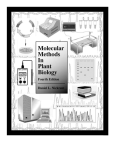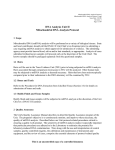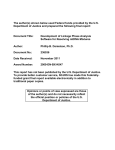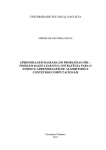Download HAPLOSEARCH SOFWARE
Transcript
HAPLOSEARCH SOFWARE User’s Manual http://www.haplosite.com/haplosearch/ 1 2 INDEX 1. INTRODUCTION ....................................................................................................................................................... 3 2. DATA FORMAT ......................................................................................................................................................... 4 2.1. SEQUENCES................................................................................................................................. 4 2.2. HAPLOTYPES ............................................................................................................................... 5 3. a) POINT MUTATIONS .......................................................................................................... 5 b) HETEROPLASMY.............................................................................................................. 6 c) INDELS .............................................................................................................................. 7 INPUT DATA FILES................................................................................................................................................... 8 3.1. TRANSFORMING SEQUENCES TO HAPLOTYPES ................................................................... 9 3.2. TRANSFORMING HAPLOTYPES INTO SEQUENCES................................................................ 10 4. OUTPUT DATA FILES............................................................................................................................................... 11 5. IMPORTANT INFORMATION ABOUT DATA FORMAT ........................................................................................... 12 5.1. ALIGNMENT .................................................................................................................................. 12 5.2. PARTIAL SEQUENCES (POPULATIONS GENETICS) ................................................................ 13 5.3. NOMENCLATURE OF DELETIONS (FORENSIC GENETICS) .................................................... 14 6. HAPLOSEARCH INTERFACE .................................................................................................................................. 15 7. REFERENCES .......................................................................................................................................................... 20 1 2 1. INTRODUCTION Human mitochondrial DNA (mtDNA) has several characteristics that makes it an invaluable tool for population genetic studies, as high copy number, small size (≈16,500 bp) and higher mutation rate than nuclear DNA. Furthermore, mtDNA is maternally inherited without recombination, allowing for the reconstruction of the evolutionary history of populations (Ballard and Whitlock, 2004). In 1981, the complete sequence of the human mtDNA was published for the first time (Anderson et al, 1981). Since that, populations from almost everywhere have been studied from the mtDNA point of view. The comparison of these large sets of mtDNA data have allowed to construct a robust phylogenetic tree (Torroni et al, 2006; van Oven and Kayser, 2009) and to estimate the global distribution and origin of each human mtDNA lineage (Cann et al, 1987; Ingman et al, 2000; Maca-Meyer et al, 2001; Richards et al, 2000). MtDNA analysis has also become an useful tool in forensic genetics, as its mode of inheritance allows testing for a putative exclusion scenario in human identification. On the other hand, when only very limited or severely degraded DNA is present in a sample, mtDNA constitutes the last chance for successful DNA typing (Parson and Bandelt, 2007). However, published data comparison is frequently complicate as mtDNA results could appear in two different formats: haplotype (detected mutations respect to a reference sequence) and nucleotide sequence data. Manual transformation between formats is time-consuming, complex and likely to introduce mistakes. Moreover, some data analyses, like haplogroup classification or matches between populations, require haplotype data. On the contrary, others, such as genetic diversity calculations, are designed for nucleotide sequences. In all cases, although some data analysis software allow you to use both formats, like Arlequin (Excoffier and Lischer, 2010), the transformation between them is usually needed as published mtDNA results could alternatively appear in both types. 3 HaploSeach software transforms haplotype and sequence data between them in a quick and easy way, allowing a fast and reliable data comparison. This program admits both partial and complete mtDNA sequences, and recognises substitution mutations (transitions and transversions), heteroplasmies and indels (insertions and deletions). Although HaploSearch was designed to analyse mtDNA sequences, it is suitable for transforming haplotypes and sequences in any kind of DNA sources. The program only requires a reference sequence from which extract the information, as occurs with the revised Cambridge Reference sequence (CRS) for mtDNA (Andrews et al, 1999). 2. DATA FORMAT 2.1. Sequences: Sequences must be introduced into the commonly used fasta format, following the IUPAC code (Cornish-Bowden, 1985). Using this format in HaploSearch allows you to obtain the complete and partial mtDNA data directly from the main databases (as GeneBank, mtDB...). To be correctly analysed, all sequences have to be equal in length, so they have to be previously aligned with the reference sequence, following the required guidelines (Bandelt and Parson, 2008). Each sequence must be written continuously, without spaces or new paragraphs. For this reason, after performing the alignment, it is encouraged to review the sequences as some aligning programs create new paragraphs into the sequence. Removing spaces or new paragraphs could be easily performed by using the “Replace” tool, which is available for the majority of text processors. As an example: >CRS AAAACCCCCTCCCC-ATGCC >SEC1 AAAACCCCCCCCCCCATGCC >SEC2 AAACCCCCCTCCCC-ATGCC 2.2. Haplotypes: 4 Mutations of haplotypes must be arranged from smaller to higher position and separated with spaces. If there are sequences that are exactly the same as the CRS reference, their haplotype would be CRS. This designation for non mutated sequences could be changed when other DNA types are studied. Using HaploSearch software, mutations could be written using two formats: “Population Genetics Nomenclature” and “Forensic Genetics Nomenclature” (following the DNA Commission of the International Society for Forensic Genetics recommendations as detailed in Carracedo et al. (2000)). a) Point mutations Point mutations are caused when exchanging a single nucleotide for another (Freese, 1959a), in respect to the CRS (or other reference sequence). These changes are classified as transitions or transversions (Freese, 1959b). a. Transition: is a mutation changing a purine to another purine nucleotide (A↔G) or a pyrimidine to another pyrimidine nucleotide (C↔T). This is the most common mutation and, for the “Population Genetic Nomenclature”, it is only designated by the nucleotide position: 0000000001111 1234567890123 CRS SEC1 CGACCCCTGTATC CGACCCTTGTGTC In this example, haplotype would be “SEC1: 7 11”, showing that SEC 1 has two transitions, in position 7 and 11, respectively. However, for the “Forensic Genetic Nomenclature”, the haplotype should be designated by the nucleotide position and the mutated base. In this case, it would be “SEC1: 7T 11G”. b. Transversion refers to the substitution of a purine for a pyrimidine or vice versa. 5 For both haplotype formats, they are designated by the nucleotide position and the changed base: 0000000001111 1234567890123 CRS SEC1 CGACCCCTGTATC CGCCCCCTTTATC Thus, haplotype would be “SEC1: 3C 9T”, showing that SEC 1 has one transversion to cytosine in position 3 and one transversion to thymine in position 9. b) Heteroplasmy The presence of more than one mtDNA haplotype in a sample is referred to as heteroplasmy. This phenomenon could be due to differential segregation of pre-existing heteroplasmic variants, to accumulation of new somatic mutations or to a combination of both. In this situations, it is necessary the use of a single symbol to designate a variety of possible nucleotides at a single position (Table 1). TABLE 1 - The IUPAC nucleotide code (Cornish-Bowden, 1985) IUPAC nucleotide code A C G T R Y S W K M B D H V N Base Adenine Cytosine Guanine Thymine A or G C or T G or C A or T G or T A or C C or G or T A or G or T A or C or T A or C or G any base 6 For both haplotype formats, they are designated by the nucleotide position and the corresponding IUPAC nucleotide code: 0000000001111 1234567890123 CRS SEC1 CGACCCCTGTATC CGACCCTTGTKTC Thus, haplotype would be “SEC1: 11K”, showing that SEC1 has heteroplasmy in position 11, where nucleotides G and T are present. c) Indels The term indel includes insertions and deletions, as these two types of genetic mutation are often considered together because of the inability to distinguish between them when comparing two sequences. This problem does not exist when sequences are compared with a reference: insertions add one or more extra nucleotides into the DNA, in respect to the reference; and deletions remove one or more nucleotides from the DNA compared with the reference sequence. Due to indels, the sequences have to be aligned before using HaploSearch, in order to designate a correct haplotype. To perform the alignment it is recommended to use alignment programs as ClustalW (http://www.ebi.ac.uk/Tools/clustalw2/index.html). a. Insertions: as insertions add one or more extra nucleotides, it is necessary to introduce gaps into the reference sequence to maintain the alignment. 0000000--001-111 1234567--890-123 CRS SEC1 CGACCCC--TGT-ATC CGACCCCCCTGTCATC To name the insertions in the “Population Genetic Nomenclature”, you must indicate the base position in which the insertion has occurred and the bases that are inserted, preceded by letter “i”. In the above example, haplotype would be “SEC1: 7iCC 10iC”. 7 For the “Forensic Genetic Nomenclature”, insertions are independently named by first noting the site immediately to the insertion followed by a decimal point and a ‘1’ (for the first insertion), a ‘2’ (if there is a second base inserted), and so on, and then by the nucleotide that is inserted. In the above example, haplotype would be “SEC1: 7.1C 7.2C 10.1C” (Carracedo et al, 2000). b. Deletions: as deletions remove one or more nucleotides from the DNA, it is necessary to introduce gaps into the studied sequence to maintain the alignment. 0000000001111 1234567890123 CRS SEC1 CGACCCCTGTATC CGACC--TGT-TC To designate deletions in the “Population Genetic Nomenclature”, you have to write the first base position of the gap and the bases that are deleted, preceded by letter “d”. In the above example, haplotype would be “SEC1: 6dCC 11dA”. For the “Forensic Genetic Nomenclature”, deletions should be recorded by listing the missing sites followed by a ‘del’. In the example, it would be “SEC1: 6del 7del 11del”. 3. INPUT DATA FILES Input data files could be written on any text processor, as long as the file is saved as a txt file. However, if a text processor with autocorrection tools (such as Microsoft Word, OpenOffice Writer or Vim) is used, this function has to be disabled in order to avoid modifications that could affect the HaploSearch operation. Indels are prone to be affected by autocorrection tools, as consecutive hyphens are exchanged for only one. This could cause the lost of alignment and, sometimes, the use of characters that are not recognised by HaploSearch. Therefore, it is encouraged to disable the autocorrection tool or to use unformatted text processors. 8 3.1. Transforming sequences into haplotypes: The input file for transforming sequences into haplotypes has to be a txt file containing the aligned sequences in fasta format. Moreover, we have to indicate what is the reference sequence and the position number for the first nucleotide in the sequence as follows: - The first line must indicate the nucleotide position for the first base of the reference sequence with the following format: “START:##”. This position would be 1 for complete sequences or to begin with the corresponding number for partial sequences. In this line, it is also possible to choose some haplotype nomenclature features (See 5.2 and 5.3 chapters for more information). - The second line must contain the reference sequence in fasta format. The reference sequence must be named “>reference_name” and would be the “>CRS” for mtDNA or any consensus sequence for other DNA types. - In the following lines, the studied sequences have to be introduced in fasta format. Example: START: 16180 >CRS AAAACCCCCTCCCCATGCC >SEC1 AAAACCCCCCCCCCATGCC >SEC2 AAACCCCCCTCCCCATGCC When sequences include indels, they have to be aligned for a correct HaploSearch analysis: START: 16180 >CRS AAAACCCCCTCCCC-ATGCC >SEC1 AAAACCCCCCCCC--ATGCC >SEC2 AAACCCCCCTCCCCCATGCC 9 3.2. Transforming haplotypes into sequences: The input file for transforming haplotypes into sequences is similar to the previous file, but using haplotype data, with whatever Population Genetic or Forensic Genetic nomenclature. As in the previous file, it has to be indicated what is the reference sequence and the position number for the first nucleotide in the reference sequence: - The first line must indicate the nucleotide position for the first base of the reference sequence with the following format: “START:##”. This position would be 1 for complete sequences or to begin with the corresponding number for partial sequences. - The second line must contain the reference sequence in fasta format. The reference sequence must be named “>reference_name” and would be “>CRS” for mtDNA or any consense sequence for other DNA types. - In the following lines, the haplotypes should be written in a similar way to the fasta format. When sequences do not include mutation, their haplotype would be the reference name. For example, when a mtDNA sequence is identical to the CRS, its haplotype would be “CRS”. Example: START: 16180 >CRS AAAACCCCCTCCCCATGCC >SEC1 16189 >SEC2 16183C 16189 16193dC >SEC3 CRS IMPORTANT INFORMATION: Reference sequence in haplotype input files would be written without hyphens as HaploSearch automatically adds gaps when indels are present. 10 4. OUTPUT DATA FILES HaploSearch output data files have the same format as the input data file for the opposite transformation. This feature allows you to obtain the original data from the output file, checking if any mistakes were introduced during data manipulation and/or HaploSearch have worked properly. If the input file is as follows: START: 16180 >CRS AAAACCCCCTCCCC--ATGCTTACAAGCAAGTACAGCAATCAACCCTCAA >SEC1 AAACCCCTCCCCCCCCATGCTTACAAGCAAGTACAGCAATCAACCTTCAA >SEC2 AAAACCCCCTCCCC--ATGCTTACAAGCAAGTACAGCAATCAACCCCCAA >SEC3 AAAACCCCCCCC----ATGCTTACAAGCAAGTACAGCAATCAACCCTCAA The output file for “Population Genetic Nomenclature” will be: START: 16180 >CRS AAAACCCCCTCCCCATGCTTACAAGCAAGTACAGCAATCAACCCTCAA >SEC1 16183C 16187 16189 16193iCC 16223 >SEC2 16224 >SEC3 16189 16192dCC Or this one, for “Forensic Genetic Nomenclature”: START: 16180 >CRS AAAACCCCCTCCCCATGCTTACAAGCAAGTACAGCAATCAACCCTCAA >SEC1 16183C 16187T 16189C 16193.1C 16193.2C 16223T >SEC2 16224C >SEC3 16189C 16192del 16193del Now, if these output files are used as input file, we could obtain the original data source. 11 5. IMPORTANT INFORMATION ABOUT DATA FORMAT: 5.1. Alignment: HaploSearch recognises the indels that are determined by the aligned input sequences. When sequences containing indels are aligned by alignment programs, the gaps are not always placed in the same position as in the commonly used nomenclature. For instance, SEC1 has four inserted Cs between 301 to 320 mtDNA positions: START:301 >rCRS AACCCCCCCTCCCCCGC >SEC1 AACCCCCCCCCCTCCCCCCGC As there are several Cs in this position, the alignment could be shown in several ways, all of them being corrected. However, every one would originate different haplotypes: rCRS: AA--CCCCCCCCT-CCCCCGC 302iCC 310iC / 302 .1C 302.2C 310.1C SEC1: AACCCCCCCCCCTCCCCCCGC rCRS: AACCCCCCCC--TCCCCC-GC 309iCC 315iC / 309.1C 309.2C 315.1C SEC1: AACCCCCCCCCCTCCCCCCGC rCRS: AAC--CCCCCCCTC-CCCCGC 303iCC 311iC / 303.1C 303.2C 311.1C SEC1: AACCCCCCCCCCTCCCCCCGC We do not know what mutational event caused these insertions, so all the different alignments are possible. However, certain indels are commonly named in a determined way. In the above example, the correct nomenclature would be “309iCC 315iC” or “309.1C 309.2C 315.1C”. This problem could be overcome by checking the alignment previous to the HaploSearch analysis (for instance, using a sequence editor as BioEdit: 12 http://www.mbio.ncsu.edu/BioEdit/BioEdit.html) and placing the variable indels in the most used place. A later modification of the output file is also possible. For alignment guidelines see Bandelt and Parson (2008). 5.2. Partial sequences (Population Genetics nomenclature) Sometimes, in population genetic studies, when only the hipervariable region I (HVRI) is analysed (positions between 16024 - 16365), the 16### notation could be omitted for clarity reasons. For example, haplotype “SEQ1: 16069 16126” would be “SEQ1: 069 126”. If you want to use this notation in HaploSearch, you should place an asterisk in the START number. For example: If you use the current notation: START: 16090 >CRS TATTTCGTACATTACTGCCAGCCACCATGA >SEQ1 TATCTCGTACATTACTGCCAGACACCATGA The output would be: START: 16090 >CRS TATTTCGTACATTACTGCCAGCCACCATGA >SEQ1 16093 16111A In other hand, if you eliminate the 16### and add an asterisk to the start number: START: 90* >CRS TATTTCGTACATTACTGCCAGCCACCATGA >SEQ1 TATCTCGTACATTACTGCCAGACACCATGA 13 The output would be: START: 90 >CRS TATTTCGTACATTACTGCCAGCCACCATGA >SEQ1 093 111A This kind of notation is only possible for Populations Genetic Nomenclature. 5.3. Nomenclature of deletions (Forensic Genetics nomenclature) As recommended by the EMPOP database, deletions are named as “del” in HaploSearch (see “Indels” section in Chapter 2). However, Carracedo et al. (2000) recommends the use of “d” instead of “del”. For this reason, there is the possibility of using “d” in HaploSearch. In this case, it is extremely important to use “D” for the heteroplasmy consisting of a mixture of A, G, and T (following IUPAC code) and “d” for deletions (See the example). For implementing this feature in HaploSearch, you only have to place a “d” next to the start number. For example: If you use the current notation: START: 16090 >CRS TATTTCGTACATTACTGCCAGCCACCATGA >SEQ1 TAT-TCGTACATTACTGCCAGACACCDTGA The output would be: START: 16090 >CRS TATTTCGTACATTACTGCCAGCCACCATGA >SEQ1 16093del 16111A 16116D 14 In other hand, if you add the letter “d” to the start number: START: 16090d >CRS TATTTCGTACATTACTGCCAGCCACCATGA >SEQ1 TAT-TCGTACATTACTGCCAGACACCDTGA The output would be: START: 16090 >CRS TATTTCGTACATTACTGCCAGCCACCATGA >SEQ1 16093d 16111A 16116D This feature is only possible for Forensic Genetic Nomenclature. 6. HAPLOSEARCH INTERFACE Using HaploSearch interface (http://www.haplosite.com/haplosearch) is simple and intuitive. To run HaploSearch, you have to select "Process", in "Topics" box. 15 Then, you have to click "Browse" button and select the input data file: Once the input data file is selected, you have to select the type of transformation: 16 Then, you have to select the type of nomenclature: And finally, press “Process”: 17 If the input data file is correct, the output data file will be ready in a very short time. When the input data file has some format mistakes, an error message will appear, indicating the origin of the error. If an unexpected error occurs, pleased contact us. See below some examples. 18 19 7. REFERENCES: Anderson S, Bankier AT, Barrell BG, de Bruijn MH, Coulson AR, Drouin J et al (1981). Sequence and organization of the human mitochondrial genome. Nature 290(5806): 457-465. Andrews RM, Kubacka I, Chinnery PF, Lightowlers RN, Turnbull DM, Howell N (1999). Reanalysis and revision of the Cambridge reference sequence for human mitochondrial DNA. Nat Genet 23(2): 147. Ballard JW, Whitlock MC (2004). The incomplete natural history of mitochondria. Mol Ecol 13(4): 729-744. Bandelt HJ, Parson W (2008). Consistent treatment of length variants in the human mtDNA control region: a reappraisal. Int J Legal Med 122(1): 11-21. Cann RL, Stoneking M, Wilson AC (1987). Mitochondrial DNA and human evolution. Nature 325(6099): 31-36. Carracedo A, Bar W, Lincoln P, Mayr W, Morling N, Olaisen B et al (2000). DNA commission of the international society for forensic genetics: guidelines for mitochondrial DNA typing. Forensic Sci Int 110(2): 79-85. Cornish-Bowden A (1985). Nomenclature for incompletely specified bases in nucleic acid sequences: recommendations 1984. Nucleic Acids Res 13(9): 3021-3030. 20 Excoffier L, Lischer HEL (2010). Arlequin suite ver 3.5: A new series of programs to perform population genetics analyses under Linux and Windows. Mol Ecol Resour in press. Freese E (1959a). The Difference between Spontaneous and Base-Analogue Induced Mutations of Phage T4. Proc of NAS 45(4): 622-633. Freese E (1959b). The Specific Mutagenic Effect of Base Analogues on Phage T4. J Mol Biol 1(87-105). Ingman M, Kaessmann H, Paabo S, Gyllensten U (2000). Mitochondrial genome variation and the origin of modern humans. Nature 408(6813): 708-713. Maca-Meyer N, Gonzalez AM, Larruga JM, Flores C, Cabrera VM (2001). Major genomic mitochondrial lineages delineate early human expansions. BMC Genet 2: 13. Parson W, Bandelt HJ (2007). Extended guidelines for mtDNA typing of population data in forensic science. Forensic Sci Int Genet 1(1): 13-19. Richards M, Macaulay V, Hickey E, Vega E, Sykes B, Guida V et al (2000). Tracing European founder lineages in the Near Eastern mtDNA pool. Am J Hum Genet 67(5): 1251-1276. Torroni A, Achilli A, Macaulay V, Richards M, Bandelt HJ (2006). Harvesting the fruit of the human mtDNA tree. Trends Genet 22(6): 339-345. 21 van Oven M, Kayser M (2009). Updated comprehensive phylogenetic tree of global human mitochondrial DNA variation. Hum Mutat 30(2): E386-394. 22
























